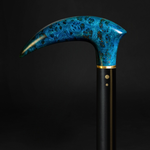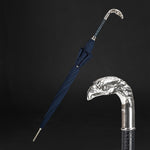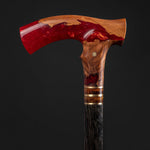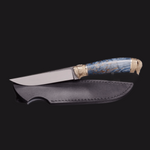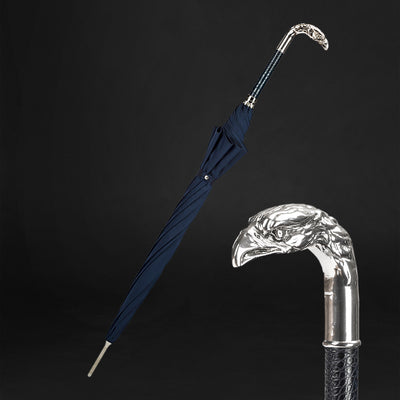You have no items in your shopping cart.
Recent Posts
-
Why an Elegant Cane Is a Thoughtful Gift for Loved Ones?
-
The Art of Christmas Design: Walking Canes That Celebrate the Season in Style
-
How an Ergonomic Walking Cane Handle Prevents Hand and Wrist Strain?
-
How to Walk With a Cane Correctly to Avoid Back or Shoulder Strain?
-
5 Common Mistakes People Make When Buying a Walking Cane (and How to Avoid Them)
-
How to Choose a Walking Cane That Reflects Your Personality (Not Just Your Needs)?
MOST POPULAR NOW
20
Oct
In today's fast-paced world, where health and fitness are of paramount importance, the simple act of taking a leisurely stroll can have a profound impact on our well-being. Walking is one of the most accessible forms of exercise, and it's an activity that people of all ages can enjoy. For those who require a walking stick, the importance of having one that is properly sized cannot be overstated. In this comprehensive guide, we will delve into why it's crucial to shorten your walking stick and explore the multitude of benefits that come with using a properly sized one.
How to shorten a walking stick?
Introduction
The importance of a properly sized walking stick
When it comes to mobility aids like walking sticks, size matters. The height of your walking stick should be tailored to your individual needs. Let's explore the reasons behind the importance of getting the right size:
1. Enhanced comfort
A walking stick that is the correct height allows you to walk with greater comfort. It supports your body weight and helps distribute it evenly, reducing the strain on your joints and muscles. This, in turn, leads to a more comfortable and pain-free walking experience.
2. Improved stability
A properly sized walking stick provides better stability. It prevents wobbling or tilting, reducing the risk of falls and injuries. This is particularly important for individuals with balance issues or those recovering from injuries.
3. Efficient posture
Using a walking stick that's the right height promotes better posture. It encourages you to stand upright, reducing the stress on your spine. Maintaining proper posture is crucial for spinal health and overall well-being.
4. Reduced fatigue
When your walking stick is the correct size, you expend less energy when walking. This results in reduced fatigue, allowing you to walk longer distances without feeling overly tired. It's a game-changer for those who enjoy long walks or hikes.
Why should you shorten your walking stick?
Now that we've established the importance of a properly sized walking stick, let's discuss why shortening it is often necessary:
1. Personalization
Every individual is unique, and so are their height, gait, and specific requirements. Shortening your walking stick allows you to customize it to your needs. It ensures that the stick provides optimal support for your body.
2. Increased maneuverability
A walking stick that's too long can be cumbersome. Shortening it increases your maneuverability, making it easier to navigate through tight spaces or crowded areas.
3. Better control
Shortening your walking stick gives you better control over your movements. This is especially crucial if you're recovering from an injury or dealing with balance issues. It minimizes the risk of accidents.
4. Reduced strain
A walking stick that's too long can strain your arm and shoulder. Shortening it to the right length ensures that your upper body remains relaxed while using it.
The benefits of properly sized walking sticks
1. Injury prevention
Using a correctly sized walking stick significantly reduces the risk of injury. It provides the support and stability you need to move safely, whether you're navigating uneven terrain or simply walking down the street.
2. Pain relief
For those with chronic pain conditions or mobility issues, a properly sized walking stick can be a source of relief. It helps distribute your body weight, reducing the strain on your joints and muscles.
3. Independence
A well-fitted walking stick empowers individuals to maintain their independence. It allows them to enjoy the freedom of movement and engage in various activities with confidence.
4. Enhanced quality of life
The benefits of a properly sized walking stick extend to an improved quality of life. It enables you to participate in social events, visit new places, and engage in physical activities that contribute to your overall well-being.
In conclusion, the significance of shortening your walking stick and using a properly sized one cannot be overstated. From enhanced comfort and stability to injury prevention and improved quality of life, the advantages are numerous. So, take the time to ensure that your walking stick is the right size for you, and experience the remarkable benefits it can offer.

Types of walking sticks
Walking sticks come in various shapes, sizes, and materials, each designed to cater to different needs and preferences. Here, we explore the most common types of walking sticks:
Traditional wooden walking sticks
Traditional wooden walking sticks are the embodiment of timeless elegance and simplicity. Crafted from materials like oak, hickory, or ash, these sticks have been a staple for centuries. Here are some key features and benefits:
1. Classic aesthetics
Traditional wooden walking sticks exude a classic charm. Their natural wood finish and often intricate carvings or designs make them a stylish accessory for daily walks or special occasions.
2. Sturdy and reliable
Wooden walking sticks are renowned for their durability. They can withstand significant weight and provide reliable support for individuals with mobility issues.
3. Customization
One of the most appealing aspects of wooden sticks is the ability to personalize them. You can have your stick custom-carved or even add unique embellishments to make it truly your own.
4. Eco-friendly
For those who value sustainability, wooden walking sticks are an eco-friendly choice. They are made from renewable resources and have a smaller environmental footprint compared to some other materials.
Adjustable hiking poles
Adjustable hiking poles, also known as trekking poles, are designed for more active outdoor adventures. They offer several advantages for hikers, trekkers, and outdoor enthusiasts:
1. Enhanced stability
Hiking poles provide added stability and balance, making them ideal for traversing uneven or challenging terrain. They reduce the risk of slips and falls.
2. Reduced strain
The ergonomic design of hiking poles helps distribute the load and reduces strain on your joints, particularly during long hikes or treks. They can be invaluable for those with knee or back issues.
3. Versatility
Hiking poles are not limited to hiking alone. They are equally useful for snowshoeing, Nordic walking, and other outdoor activities. Their adjustable length makes them versatile for various situations.
4. Compact and portable
Many hiking poles can be collapsed for easy storage and transport. This feature is especially convenient for those who like to travel light.
Folding canes
Folding canes are a practical choice for individuals who require mobility assistance but also need the option of easy storage and transport. Here's why they are a popular choice:
1. Portability
Folding canes can be conveniently folded into a compact size, making them easy to stow away in a bag or suitcase. This feature is essential for those on the go.
2. Adjustable height
Most folding canes come with adjustable height settings, allowing users to find the most comfortable position. This adaptability ensures a proper fit for different individuals.
3. Lightweight
Folding canes are typically made from lightweight materials such as aluminum. This makes them easy to carry and handle, even for extended periods.
4. Stylish options
Modern folding canes are available in a variety of stylish designs and colors, allowing users to express their individuality while maintaining their mobility.
In summary, the choice of a walking stick should align with your specific needs and lifestyle. Traditional wooden walking sticks offer a touch of class and customization. Adjustable hiking poles provide stability and support for outdoor enthusiasts. Folding canes offer portability and adaptability for those constantly on the move. Whichever type you choose, the right walking stick can significantly enhance your mobility and overall quality of life.
Preparing for shortening
Before embarking on the task of shortening a walking stick to the appropriate length, there are essential preparations that need to be made to ensure the process is smooth and the end result is perfectly tailored to your needs. In this guide, we will discuss two key steps in the preparation process:
Gather necessary tools
Shortening a walking stick requires the right tools to achieve a precise and satisfactory outcome. Here's a list of the tools you'll need:
1. Measuring tape: A measuring tape is essential for accurately measuring the length of the walking stick and ensuring that the adjustments are made correctly.
2. Saw: A saw, such as a hacksaw or a specialized walking stick saw, is necessary to cut the stick to the desired length.
3. Sandpaper: Sandpaper will be used to smooth the cut ends of the walking stick, ensuring there are no rough or sharp edges.
4. Marker or pencil: You'll need a marker or pencil to mark the desired length on the walking stick before cutting.
5. Workbench or vise: To secure the walking stick in place while cutting and sanding, a workbench or vise is highly recommended to provide stability.
6. Protective gear: Safety should be a priority. Wear safety goggles and gloves to protect your eyes and hands while working with tools.
7. User manual: If your walking stick came with a user manual, consult it for specific instructions on shortening or adjusting the stick.
Understand your body measurements
To determine the ideal length for your walking stick, it's crucial to have a clear understanding of your body measurements. Here's how to go about it:
1. Stand upright: Stand in your natural walking posture, with your arms hanging comfortably by your sides.
2. Measure from floor to wrist: Have a friend or family member measure the distance from the floor to your wrist while your arms are relaxed. This measurement is a good starting point for your walking stick's length.
3. Consider the terrain: Think about where you'll be using the walking stick. If it's mainly for indoor use, a shorter length might be suitable. For outdoor or rugged terrain, a slightly longer stick may be more beneficial.
4. Trial and error: It's advisable to start with a longer walking stick and gradually shorten it as needed. This allows you to fine-tune the length to your comfort.
5. Seek professional advice: If you have specific mobility or medical needs, it's wise to consult a healthcare professional or physical therapist for guidance on the ideal walking stick length.
By gathering the necessary tools and understanding your body measurements, you set the stage for a successful shortening process. Remember that the goal is to customize the walking stick to your unique requirements, ensuring that it provides the support and comfort you need for a safer and more enjoyable walking experience.
Measuring your ideal stick length
Selecting the correct length for your walking stick is a critical step in ensuring that it provides the support and comfort you need. In this guide, we will cover two essential aspects of determining the ideal walking stick length:
Determining your ideal walking stick length
To find your ideal walking stick length, follow these steps:
1. Stand upright: Stand in your natural walking posture, with your arms relaxed by your sides.
2. Measure from floor to wrist: Have someone assist you in measuring the distance from the floor to your wrist. Ensure that your arms are hanging comfortably, and the measurement is taken in a straight line from the floor to the crease of your wrist.
3. Adjust for terrain: Consider where you'll be using the walking stick. For general use, the walking stick should reach the crease of your wrist. However, if you'll be on uneven terrain, you may opt for a slightly longer stick for added stability.
4. Trial and error: It's often helpful to start with a longer stick and gradually shorten it as needed. This allows you to fine-tune the length according to your comfort and requirements.
5. Seek professional advice: If you have specific mobility concerns or medical needs, consult a healthcare professional or physical therapist for guidance on the ideal walking stick length.
The role of your height
Your height plays a significant role in determining the appropriate walking stick length:
1. Taller individuals: If you are taller, you will generally require a longer walking stick to maintain the correct posture and support your weight effectively.
2. Shorter individuals: For shorter individuals, a shorter walking stick is typically more suitable. It helps prevent unnecessary strain on your arms and shoulders.
3. Children and younger users: When choosing a walking stick for a child or a younger individual, it's important to select one that can be adjusted as they grow. Look for sticks with adjustable height settings.
4. Seniors and individuals with mobility issues: Seniors and those with mobility issues may need to consider additional factors such as balance and stability when selecting a walking stick. Seeking professional guidance is advisable.
In conclusion, finding the ideal walking stick length is crucial for your comfort and safety. By measuring from the floor to your wrist and considering your height, you can select a walking stick that provides the necessary support and stability for your unique needs. Remember that there is no one-size-fits-all solution, and it's perfectly acceptable to adjust and experiment to find the perfect length for your walking stick.
Shortening traditional wooden walking sticks
Traditional wooden walking sticks exude a timeless elegance, and if you find that your stick is too long for your needs, shortening it can be a necessary adjustment. Here, we will guide you through the process of shortening a traditional wooden walking stick with two key steps:
Trimming techniques
Shortening a traditional wooden walking stick involves cutting it to the desired length. Follow these techniques for a precise cut:
1. Measure twice: Begin by measuring the exact length you want the walking stick to be. Use a measuring tape or ruler to ensure accuracy.
2. Mark the spot: Use a marker or pencil to mark the spot where you intend to make the cut. Ensure the mark is clear and visible.
3. Secure the walking stick: Clamp the walking stick securely to a workbench or vise. This stability is crucial to prevent any accidents while cutting.
4. Choose the right saw: Select a suitable saw for the job. A hacksaw or a specialized walking stick saw works well. Ensure the saw is sharp for a clean cut.
5. Cut carefully: Align the saw with the marked spot and cut steadily. Make sure to follow the marked line precisely. Use slow and controlled strokes to avoid splintering.
6. Smooth the cut end: After the cut, use sandpaper to smooth the newly cut end. Sand in a downward motion to prevent splinters. Continue sanding until the end is smooth to the touch.
Sanding and smoothing
Once you've cut the walking stick to the desired length, the next step is to sand and smooth the surface:
1. Select the right sandpaper: Choose sandpaper with a medium grit, such as 100 or 120. This is suitable for smoothing the wood.
2. Sand the cut end: Gently sand the cut end of the walking stick in a downward motion. This helps remove any rough edges and splinters.
3. Gradually increase grit: After smoothing with medium-grit sandpaper, switch to a finer grit, such as 220 or 320. This will provide a smoother finish.
4. Smooth the entire stick: Consider sanding the entire surface of the walking stick to maintain a consistent and polished appearance. Sand in the direction of the wood grain.
5. Apply finish (optional): If desired, you can apply a wood finish or varnish to protect the wood and give it an attractive sheen. Follow the product instructions for application.
6. Final inspection: Once you are satisfied with the smoothness and appearance of the walking stick, give it a final inspection to ensure there are no sharp edges or imperfections.
By following these trimming techniques and sanding steps, you can effectively shorten a traditional wooden walking stick to the desired length while maintaining a polished and safe finish. Remember to prioritize safety by wearing protective gear and using the right tools for the job.
Shortening folding canes
Folding canes are popular for their portability and adaptability. If you find that your folding cane is too long, shortening it is a straightforward process. Here, we will guide you through the steps to shorten a folding cane with a focus on two key aspects:
Removing excess segments
Shortening a folding cane involves removing excess segments to reach the desired length. Here's how to do it:
1. Examine the cane: Begin by unfolding the cane and taking a close look at its structure. Folding canes typically consist of several telescoping segments.
2. Measure twice: Determine the exact length to which you want to shorten the cane. Use a measuring tape or ruler for precision.
3. Locate the adjustment mechanism: Identify the locking or adjustment mechanism on the cane. This mechanism may involve buttons, screws, or a twist-and-lock design.
4. Unlock the cane: Carefully unlock the cane's adjustment mechanism. This is usually done by pressing the buttons, loosening screws, or untwisting the sections.
5. Remove excess segments: Once the cane is unlocked, gently slide out the excess segments. Be cautious to follow the manufacturer's instructions and avoid forcing the segments out.
6. Trim if necessary: In some cases, you may need to trim the ends of the segments you've removed to ensure a clean fit. Use a saw or cutting tool suitable for the material of the cane.
7. Secure the cane: After removing the excess segments, securely fasten the remaining segments back together using the adjustment mechanism.
Ensuring proper folding
Maintaining the folding functionality of your cane is essential after shortening it. Here's how to ensure proper folding:
1. Test the folding mechanism: Ensure that the folding mechanism still works smoothly after shortening the cane. If the mechanism is compromised, consider consulting the manufacturer or a professional for adjustments.
2. Check for sturdiness: Verify that the cane feels stable and secure when unfolded. Shake it gently to make sure it won't collapse unintentionally.
3. Secure locking mechanism: If your cane has a locking mechanism, ensure it clicks securely into place when the cane is unfolded. This prevents accidental folding during use.
4. Perform trial walks: Take a few practice walks with the shortened cane to ensure that it provides the support and comfort you need.
5. Regular maintenance: Periodically check the cane's folding mechanism and locking features to ensure they continue to function properly.
By following these steps to remove excess segments and ensure proper folding, you can effectively shorten a folding cane to your desired length while maintaining its functionality and safety. Always adhere to the manufacturer's guidelines and recommendations to ensure the cane's optimal performance.
Safety precautions
When shortening walking sticks, whether they are traditional wooden walking sticks or folding canes, it's essential to prioritize safety. Here are two key safety precautions to follow throughout the shortening process:
Avoiding splinters and sharp edges
Woodworking projects, including shortening traditional wooden walking sticks, can potentially lead to splinters and sharp edges. To avoid these hazards, consider the following precautions:
1. Wear safety gear: Prior to starting, put on safety goggles to protect your eyes from wood particles and gloves to shield your hands from splinters.
2. Inspect the wood: Examine the walking stick for any existing splinters or rough spots. Sand them down before you begin the shortening process.
3. Use sharp tools: Ensure your cutting tools, whether it's a saw or a specialized walking stick saw, are sharp and in good condition. Dull tools can cause rough cuts and splintering.
4. Cut carefully: When cutting the walking stick, use slow and controlled motions. Rushing can result in splinters and uneven edges. Follow the marked line precisely.
5. Sand smoothly: After cutting, use sandpaper to smooth the cut end. Sand in a downward motion to prevent splinters and rough edges. Gradually increase the grit for a smoother finish.
6. Inspect for splinters: After sanding, inspect the cut end carefully for any remaining splinters. Remove them with additional sanding if necessary.
Ensuring structural integrity
Maintaining the structural integrity of the walking stick is crucial to ensure it provides reliable support. Follow these precautions:
1. Check for weakness: Before and after shortening the walking stick, inspect it for any signs of weakness, cracks, or damage. A weakened stick can compromise safety.
2. Ensure proper adjustments: If your walking stick is adjustable, make sure that the adjustment mechanism functions correctly and securely. It should hold the desired length without slipping.
3. Stability testing: After shortening the stick, test it for stability by applying pressure and weight. Ensure it can support your body weight without wobbling or collapsing.
4. Regular inspections: Periodically inspect the walking stick for any wear and tear. Check for loose components, and tighten them if needed.
5. Replace if necessary: If you notice any structural issues or significant wear and tear, consider replacing the walking stick to ensure your safety and stability.
By following these safety precautions, you can minimize the risk of splinters, sharp edges, and structural issues while shortening your walking stick. Prioritizing safety is essential to ensure that your walking stick continues to provide the support and comfort you need.

Summary of key points
In summary, let's recap the essential points related to the shortening of walking sticks and the benefits of having a well-shortened walking stick:
Recap of the shortening process
- Measure twice: Determine the desired length and measure accurately.
- Secure the cane: Use a workbench or vise to secure the walking stick.
- Select the right saw: Choose an appropriate saw for the material.
- Cut carefully: Make precise and controlled cuts to avoid splinters.
- Sand and smooth: After cutting, use sandpaper to ensure a smooth finish.
- Maintain structural integrity: Regularly inspect the walking stick for damage or wear.
Benefits of a well-shortened walking stick
- Enhanced comfort: A well-shortened walking stick reduces strain and discomfort.
- Better stability: It provides improved balance and stability, reducing the risk of falls.
- Efficient posture: Proper length encourages better posture and spinal health.
- Reduced fatigue: Shortening reduces energy expenditure and lessens fatigue.
- Personalization: Customizing the walking stick ensures it meets your specific needs.
Shortening a walking stick is a precise process that, when done correctly, results in a more comfortable and effective mobility aid. A well-shortened walking stick offers numerous benefits, from enhanced comfort and stability to reduced fatigue and improved posture, all contributing to a better quality of life.
FAQs
Here are answers to some common questions related to walking sticks and the shortening process:
A. Can I revert the shortening process?
Once a walking stick has been shortened, it's challenging to revert it to its original length. This is because the removed segments cannot be reattached. It's essential to carefully consider the desired length before making any cuts. If you need a longer walking stick, it's often more practical to acquire a new one.
B. What are the best materials for handles?
The choice of handle material depends on your preferences and comfort. Common handle materials include rubber, foam, and wood. Rubber handles provide a soft, non-slip grip, foam handles are comfortable and lightweight, while wood handles offer a classic and elegant appearance. The best material for you depends on your personal preferences and any specific requirements you have for your walking stick.
C. What if I don't have the tools?
If you don't have the necessary tools for shortening your walking stick, it's advisable to seek assistance from a professional or a local woodworking shop. They have the expertise and tools required to make precise cuts and adjustments safely. Attempting to shorten a walking stick without the right tools can result in uneven cuts and safety risks.
D. How does weather affect walking stick length?
Walking sticks, especially wooden ones, can be affected by changes in humidity. In damp conditions, wood can absorb moisture and expand, causing the stick to lengthen slightly. Conversely, in dry conditions, wood can lose moisture and contract, causing the stick to shorten. It's essential to store your walking stick in a controlled environment to minimize these effects and maintain its stability and integrity. Regular inspections can help ensure your walking stick remains the correct length.
Conclusion
In the journey to better mobility, embracing the shortened walking stick is a pivotal step. Shortening a walking stick isn't just about making it fit your height; it's about customizing it to your unique needs and preferences, ensuring that it becomes a seamless extension of your support system.
A well-shortened walking stick is more than just a mobility aid; it's a companion that offers you enhanced comfort, stability, and freedom. As you walk with a walking stick that is the perfect length for your body and the terrain you navigate, you'll experience the benefits firsthand.
It's not just about the inches you've taken off the stick; it's about the inches you've added to your stride, the freedom you've gained, and the journey to better mobility. With the right length walking stick in hand, you can confidently step into the world, knowing that each stride is supported, each challenge is surmountable, and your path to a better quality of life is well within reach.
So, whether you're embarking on an adventure, strolling through your neighborhood, or simply taking a leisurely walk, let your well-shortened walking stick be your trusted companion. Embrace the comfort, stability, and independence it provides, and revel in the journey to better mobility that lies ahead.
Also Purchased
-
Beige Walking Cane for Ladies Chamomile Flower, Wooden Walking Stick
Introducing our beautiful Beige Walking Cane for Ladies with Chamomile Flower, a Wooden Walking Stick that is hand carved and handmade, making it both pretty and unique. This walking cane...$90.00$79.50 -
Black Skull Head Walking Stick, Wedding Ceremony Designer Skull
Looking for a stylish and unique walking stick to elevate your look at your next event? Check out our Black Skull Head Walking Stick, the perfect accessory for any wedding...From $217.00 -
Exotic Burl Wood Walking Cane – Fashionable Artisan Stick
A sculptural statement in deep, oceanic blue — this walking cane is more than a support accessory, it's wearable art. Meticulously hand-shaped from stabilized burl wood, the handle evokes the...$425.00 -
ArtWalkingSticks™ MAGIC Walking Cane, Handmade - Make to Order
This piece of art is created for those who value details. We make one of a kind, handcrafted wood and resin canes. Our Wooden Canes are completely unmatched in creativity....$430.00 -
Umbrella with Eagle Handle, Fashion Umbrella For Men
Make a bold and fashionable statement with our Umbrella with Eagle Handle - a unique and functional accessory designed for men. The striking eagle handle is the highlight of this...$325.00 -
Fashionable Lion Shoehorn Long Handle, Pearly Brown Shaft, Handmade
Introducing our Fashionable Lion Shoehorn, a handcrafted, long-handled shoe horn with a pearly brown shaft that's both stylish and practical. The intricate Lion design adds a touch of elegance to...$240.00
















